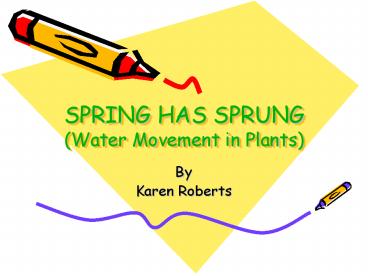SPRING HAS SPRUNG Water Movement in Plants - PowerPoint PPT Presentation
1 / 14
Title:
SPRING HAS SPRUNG Water Movement in Plants
Description:
Xylem-water conducting tissue. The xylem tissue forms narrow tubes in which capillary action helps move water upward. ... ( xylem and phloem) ... – PowerPoint PPT presentation
Number of Views:801
Avg rating:3.0/5.0
Title: SPRING HAS SPRUNG Water Movement in Plants
1
SPRING HAS SPRUNG(Water Movement in Plants)
- By
- Karen Roberts
2
- Movement of Water in Plants
- Do the Science lab.
- Heres what youll need.
- O.K., so heres the challenging question.
- Web links
3
- With the coming of spring the days get longer,
the air gets warmer, and the birds begin to sing.
As you look around, you may see many changes
taking place but the most stunning transformation
has to be in the plants. - Almost magically, barren branches start to bud,
brown grass turns green, and tiny little shoots
push up through the soil. - How does this happen?
- Does mother nature need a wakeup call?
4
- Well, in a sense, yes. But one way that plants
awaken is with water. - In fact, you could say that when the water starts
flowing, its keen to be green!!
5
- Ive got a challenge for you that lets you get to
the bottom of how water gets to the top of the
plant. First a little background information on
the subject!
- How does water move around in plants?
- Vascular system Phloem-food conducting
tissue. Xylem-water conducting
tissue. The xylem tissue forms narrow tubes in
which capillary action helps move water upward. - Do the leaves pull it up, or are their other
forces at play?
6
- Water and minerals absorbed by roots of a plant
move up the stem to the leaves, while sugar
formed by photosynthesis moves from leaves to
stems and the underground root system. Plants
have tissues specialized for conduction which
make up the vascular system. (xylem and phloem) - Other factors involved in upward movement of
water are osmotic pressure and transpiration
pull. - Osmotic pressure contributes to upward movement
because water moves from areas of higher
concentration (soil) to areas of lower
concentration (roots). Transpiration is the loss
of water from leaves. Transpiration pull is the
pulling up of water into the leaf to replace the
water lost by transpiration or used by
photosynthesis.
7
- Heres what youll need to begin.
- 2 large glasses of water.
- Some red food coloring.
- 2 fresh stalks of celery with leaves.
- A spoon.
- A plastic knife.
8
Now for the Lab!
- Begin by putting 2 or 3 drops of food coloring in
each glass of water and mix them up with the
spoon. - Take the celery stalk and remove all the leaves
from it. - Leave the other alone.
- Use the knife to cut about 1 centimeter up from
the bottom of each stalk and place each stalk in
one of the glasses with the red water.
9
- Put the two glasses, each containing a celery
stalk, side by side in direct sunlight (or under
a lamp) and allow them to sit for about 24 hours.
10
OKAY, SO HERES THE CHALLENGE QUESTION
- Which stalk of celery do you think will drink
up the most water? - The one with leaves or the one without leaves?
11
- Before starting the experiment write your
predictions. - After youve let the celery sit for 24 hours, cut
off the tops of the celery to see if the inside
is dyed red.
12
- Do leaves help to pull up the water, or does it
get through the plant by some other means? - I know youre dying to find out, so get busy
and make your predications!!
13
What Are We Going To Learn
- Using food coloring, we are going to track the
movement of water through two celery stalks-one
with and one without leaves. - Observe the path that water takes to get to a
leaf. - Predict how leaves affect plants absorption of
water. - Observe the capillary action in plants.
14
Web Links
- For more information on plants, try these Web
sites. - Welcome to Missouri Botanical Garden
- http//mbgnet.mobot.org
- University of Wisconsin-Madison Botanical Garden
- http//www.wisc.edu/botany/Garden/































